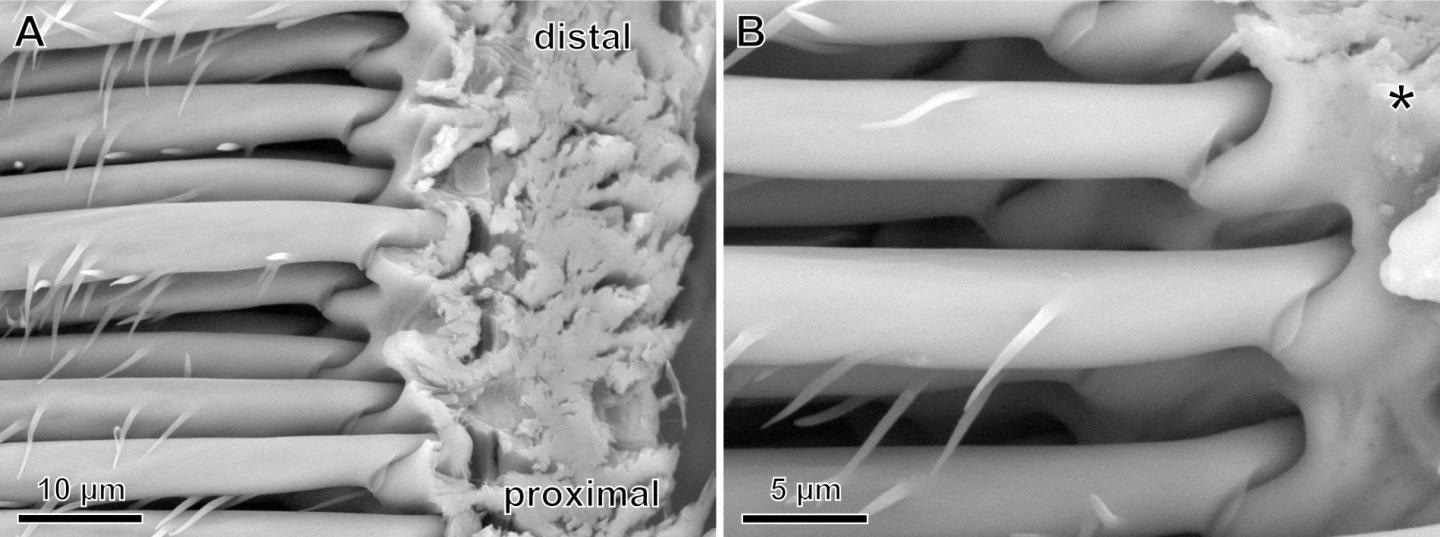Jun 21 2021
Spiders can walk on different types of surfaces, like walking straight up and even upside-down across, but how precisely they do this is not known.
 Scanning Electron Microscopy (SEM) image of the bases of pretarsal (i.e, on the lowest part of the leg) adhesive hairs. (A) On the left are the hair shafts of the adhesive hairs closest to the exoskeleton. At their insertion, the hair shaft becomes thinner and a stopper-like structure on the exoskeleton meets and attaches to it. (b) Further magnification of the same region: the asterisk marks the pivot point where hairs can bend upwards. Distal vs. proximal here means away from vs. towards the claw on the tip of the leg. Image Credit: B Poerschke, SN Gorb and F Schaber.
Scanning Electron Microscopy (SEM) image of the bases of pretarsal (i.e, on the lowest part of the leg) adhesive hairs. (A) On the left are the hair shafts of the adhesive hairs closest to the exoskeleton. At their insertion, the hair shaft becomes thinner and a stopper-like structure on the exoskeleton meets and attaches to it. (b) Further magnification of the same region: the asterisk marks the pivot point where hairs can bend upwards. Distal vs. proximal here means away from vs. towards the claw on the tip of the leg. Image Credit: B Poerschke, SN Gorb and F Schaber.
Analyzing this aspect could pave the way for producing bio-inspired, powerful, yet reversible adhesives. For several decades, scientists have been working to get a better understanding of spiders’ feet.
Now, a new study, published in the Frontiers in Mechanical Engineering journal, has demonstrated for the first time that the characteristics of the hair-like structures that form the adhesive feet of Cupiennius salei — the wandering spider — are more variable than previously believed.
When we started the experiments, we expected to find a specific angle of best adhesion and similar adhesive properties for all of the individual attachment hairs. But surprisingly, the adhesion forces largely differed between the individual hairs, e.g. one hair adhered best at a low angle with the substrate while the other one performed best close to perpendicular.
Dr Clemens Schaber, Study Group Leader, University of Kiel
The feet of Cupiennius salei are composed of around 2,400 tiny hairs or “'setae” (one-hundredth of one millimeter thick). Schaber and his co-workers Bastian Poerschke and Stanislav Gorb, obtained a sample of these hairs and then determined how well they adhere to a range of smooth and rough surfaces, which also include glass. The team investigated the performance of these hairs at various contact angles.
Different Types of Hair Work Together
Surprisingly, each hair displayed special adhesive properties. When observed under a powerful microscope, the researchers found that each hair showed previously unrecognized and clearly different structural arrangements. According to the researchers, this variety could be key to understand how spiders are able to climb many types of surfaces.
The new study focused only on a small number of the thousands of hairs on each foot because the resources were too limited to study them all. However, the team believes that not all hairs are unique and that there is a possibility of finding clusters or repeating patterns instead.
Bioinspired Applications Possible
Although it is still very difficult to fabricate nanostructures like those of the spider – and especially to achieve the stability and reliability of the natural materials — our findings can further optimize existing models for reversible and residue-free artificial adhesives. The principle of different shapes and alignments of adhesive contacts as found in the spider attachment system can improve the attachment ability of bioinspired materials to a broad range of substrates with different properties.
Dr Clemens Schaber, Study Group Leader, the University of Kiel in Germany
Journal Reference:
Poerschke, B., et al. (2021) Adhesion of Individual Attachment Setae of the Spider Cupiennius salei to Substrates With Different Roughness and Surface Energy. Frontiers in Mechanical Engineering. doi.org/10.3389/fmech.2021.702297.